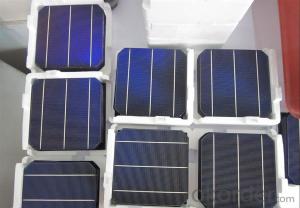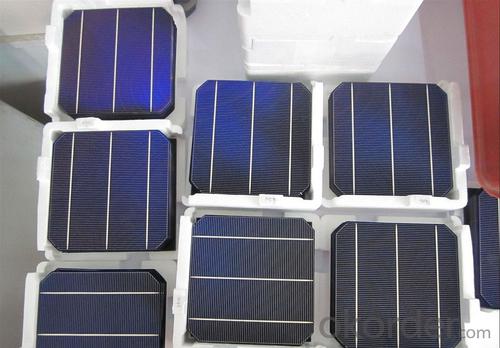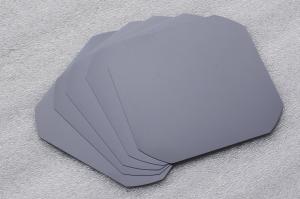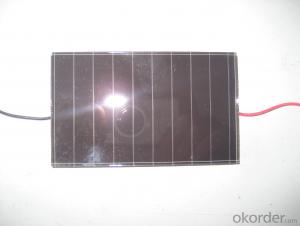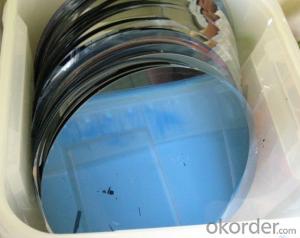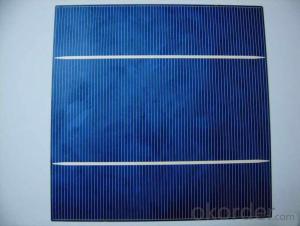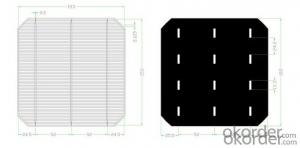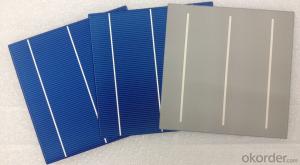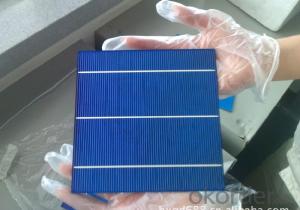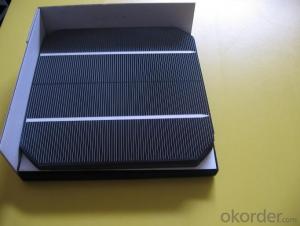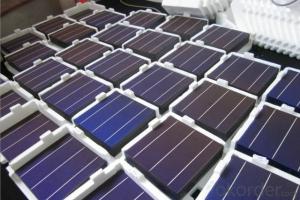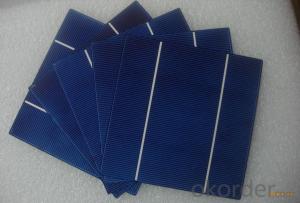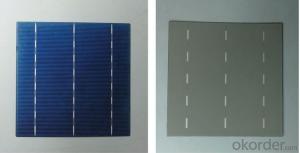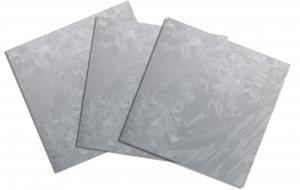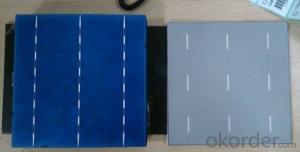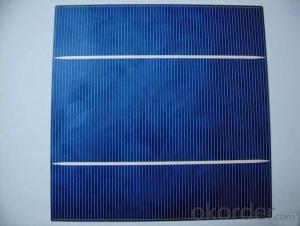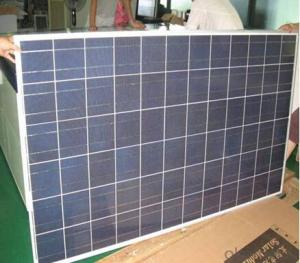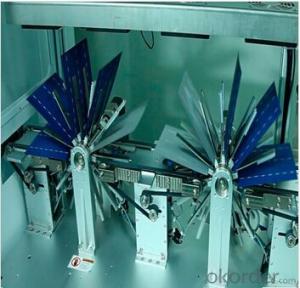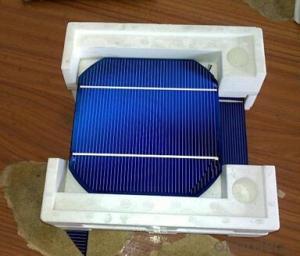Solar Silicon Wafer Cassette Supplier - High Quality A Grade Polycrystalline 5V 16.4% Solar Cell
- Loading Port:
- Shanghai
- Payment Terms:
- TT OR LC
- Min Order Qty:
- 1000 pc
- Supply Capability:
- 100000 pc/month
OKorder Service Pledge
OKorder Financial Service
You Might Also Like
Specifications
hot sale solar cell
1.16.8%~18.25% high efficiency
2.100% checked quality
3.ISO9001/ISO14001/TUV/CE/UL
4.stable performance
We can offer you the best quality products and services, don't miss !
POLY6'(156*156)
Polycrystalline Silicon Solar cell
Physical Characteristics
Dimension: 156mm×156mm±0.5mm
Diagonal: 220mm±0.5mm
Thickness(Si): 200±20 μm
Front(-) Back(+)
Blue anti-reflecting coating (silicon nitride); Aluminum back surface field;
1.5mm wide bus bars; 2.0mm wide soldering pads;
Distance between bus bars: 51mm . Distance between bus bars :51mm .
Electrical Characteristics
Efficiency(%) | 18.00 | 17.80 | 17.60 | 17.40 | 17.20 | 16.80 | 16.60 | 16.40 | 16.20 | 16.00 | 15.80 | 15.60 |
Pmpp(W) | 4.33 | 4.29 | 4.24 | 4.19 | 4.14 | 4.09 | 4.04 | 3.99 | 3.94 | 3.90 | 3.86 | 3.82 |
Umpp(V) | 0.530 | 0.527 | 0.524 | 0.521 | 0.518 | 0.516 | 0.514 | 0.511 | 0.509 | 0.506 | 0.503 | 0.501 |
Impp(A) | 8.159 | 8.126 | 8.081 | 8.035 | 7.990 | 7.938 | 7.876 | 7.813 | 7.754 | 7.698 | 7.642 | 7.586 |
Uoc(V) | 0.633 | 0.631 | 0.628 | 0.625 | 0.623 | 0.620 | 0.618 | 0.617 | 0.615 | 0.613 | 0.611 | 0.609 |
Isc(A) | 8.709 | 8.677 | 8.629 | 8.578 | 8.531 | 8.478 | 8.419 | 8.356 | 8.289 | 8.220 | 8.151 | 8.083 |
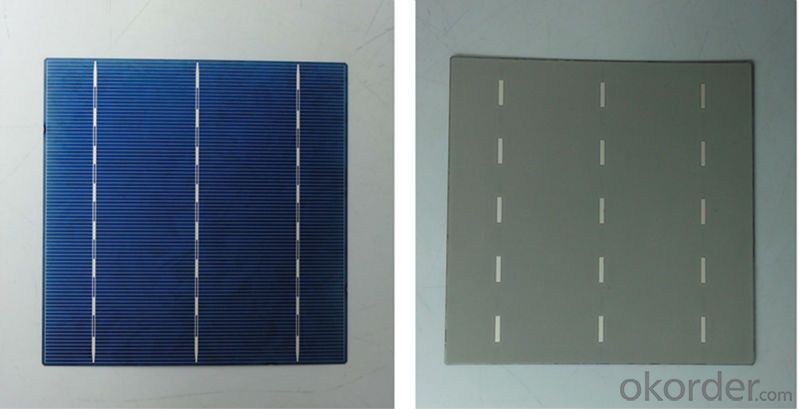
MONO5'(125*125mm)165
Monocrystalline silicon solar cell
Physical Characteristics
Dimension: 125mm×125mm±0.5mm
Diagonal: 165mm±0.5mm
Thickness(Si): 200±20 μm
Front(-) Back(+)
Blue anti-reflecting coating(silicon nitride); Aluminum back surface field;
1.6mmwide bus bars; 2.5mm wide soldering pads;
Distance between bus bars: 61mm . Distance between bus bars :61mm .
Electrical Characteristics
Efficiency(%) | 19.40 | 19.20 | 19.00 | 18.80 | 18.60 | 18.40 | 18.20 | 18.00 | 17.80 | 17.60 | 17.40 | 17.20 |
Pmpp(W) | 2.97 | 2.94 | 2.91 | 2.88 | 2.85 | 2.82 | 2.79 | 2.76 | 2.73 | 2.70 | 2.67 | 2.62 |
Umpp(V) | 0.537 | 0.535 | 0.533 | 0.531 | 0.527 | 0.524 | 0.521 | 0.518 | 0.516 | 0.515 | 0.513 | 0.509 |
Impp(A) | 5.531 | 5.495 | 5.460 | 5.424 | 5.408 | 5.382 | 5.355 | 5.328 | 5.291 | 5.243 | 5.195 | 4.147 |
Uoc(V) | 0.637 | 0.637 | 0.636 | 0.635 | 0.633 | 0.630 | 0.629 | 0.629 | 0.628 | 0.626 | 0.626 | 0.625 |
Isc(A) | 5.888 | 5.876 | 5.862 | 5.848 | 5.839 | 5.826 | 5.809 | 5.791 | 5.779 | 5.756 | 5.293 | 5.144 |

FAQ:
Q:How can i get some sample?
A:Yes , if you want order ,sample is not a problem.
Q:How about your solar panel efficency?
A: Our product efficency around 17.25%~18.25%.
Q:What’s the certificate you have got?
A: we have overall product certificate of ISO9001/ISO14001/CE/TUV/UL
- Q: What is the expected future development of solar silicon wafers?
- The expected future development of solar silicon wafers involves advancements in efficiency, cost reduction, and increased sustainability. Technological innovations like thinner wafers, improved manufacturing processes, and the integration of novel materials are likely to enhance the efficiency of solar cells. Additionally, the use of advanced manufacturing techniques such as heterojunction technology and passivated emitter rear contact (PERC) technology is expected to further improve the performance of solar silicon wafers. Furthermore, research efforts are focused on developing sustainable and environmentally friendly methods for silicon production, such as recycling and utilizing lower-grade silicon sources. Overall, the future holds great potential for solar silicon wafers to become more efficient, cost-effective, and eco-friendly, thereby contributing to the widespread adoption of solar energy.
- Q: How are solar silicon wafers affected by surface recombination velocity?
- Solar silicon wafers are greatly affected by surface recombination velocity. A higher surface recombination velocity leads to increased recombination of charge carriers at the surface, reducing the efficiency of solar cells. To mitigate this, techniques such as passivation are employed to minimize surface recombination, thus enhancing the performance and overall efficiency of solar silicon wafers.
- Q: How do solar silicon wafers perform in extreme weather conditions?
- Solar silicon wafers generally perform well in extreme weather conditions. They are designed to withstand high temperatures, humidity, and even harsh weather elements such as snow and hail. However, extreme conditions like excessive heat or cold can slightly affect their efficiency. Overall, solar silicon wafers are engineered to be durable and reliable, making them suitable for various weather conditions.
- Q: How are solar silicon wafers affected by humidity and moisture?
- Solar silicon wafers are adversely affected by humidity and moisture. Moisture can cause corrosion and oxidation of the wafer's surface, leading to reduced efficiency and performance of the solar cell. High humidity levels can also result in the formation of water droplets on the wafer, which can create shading and impact the generation of electricity. Therefore, it is crucial to protect solar silicon wafers from excessive humidity and moisture to ensure their optimal functioning and longevity.
- Q: Can solar silicon wafers be used in solar-powered medical devices?
- Yes, solar silicon wafers can be used in solar-powered medical devices. Solar silicon wafers are a common component in solar panels, which convert sunlight into electricity. By utilizing solar silicon wafers, medical devices can harness solar energy to power their operations, providing an eco-friendly and sustainable energy source. This can be particularly beneficial in remote or off-grid medical settings where access to conventional power sources may be limited.
- Q: How much does a solar silicon wafer weigh?
- A typical solar silicon wafer weighs around 4 to 6 grams.
- Q: How are solar silicon wafers affected by light trapping techniques?
- Light trapping techniques can significantly enhance the performance of solar silicon wafers. These techniques aim to increase the absorption of sunlight within the wafer, allowing it to capture more photons and generate more electricity. By incorporating textured or nanostructured surfaces, antireflection coatings, or using backside reflectors, light trapping techniques can effectively reduce the reflection and transmission of light, thereby increasing the overall conversion efficiency of solar cells.
- Q: How do solar silicon wafers perform in tropical environments?
- Solar silicon wafers perform well in tropical environments due to their durability and resistance to high temperatures and humidity. The materials used in the production of these wafers are designed to withstand harsh weather conditions, including intense sunlight, heavy rainfall, and extreme temperatures. Additionally, solar panels are typically installed with proper ventilation to prevent any heat buildup, ensuring their optimal performance in tropical climates.
- Q: How do solar silicon wafers handle extreme temperatures?
- Solar silicon wafers are designed to handle extreme temperatures quite well. They are typically made from high-grade silicon materials that can withstand both very high and low temperatures. The silicon material has a high melting point and excellent thermal stability, allowing it to handle the heat generated from sunlight and the surrounding environment. Additionally, solar cells are often encapsulated with protective layers and materials that provide further insulation and temperature resistance. This ensures that solar silicon wafers can continue to generate electricity efficiently, even in extreme temperature conditions.
- Q: Wafer cutting, NTC442 machine, a knife can cut how many pieces? How long is a piece of silicon?
- Do not stick stick with the United States and the United States, the line will be glued to the line together. With the kind of 3M model of the United States and rubber repair jumper glue will not stick on the line, if the jumper is too much can be inserted in the United States and the United States to close the line has been going to the end.
Send your message to us
Solar Silicon Wafer Cassette Supplier - High Quality A Grade Polycrystalline 5V 16.4% Solar Cell
- Loading Port:
- Shanghai
- Payment Terms:
- TT OR LC
- Min Order Qty:
- 1000 pc
- Supply Capability:
- 100000 pc/month
OKorder Service Pledge
OKorder Financial Service
Similar products
Hot products
Hot Searches
Related keywords
